 Willliam Wycherley, 1670s |
 Edward Bond, 1965 |
 Willliam Wycherley, 1670s |
 Edward Bond, 1965 |



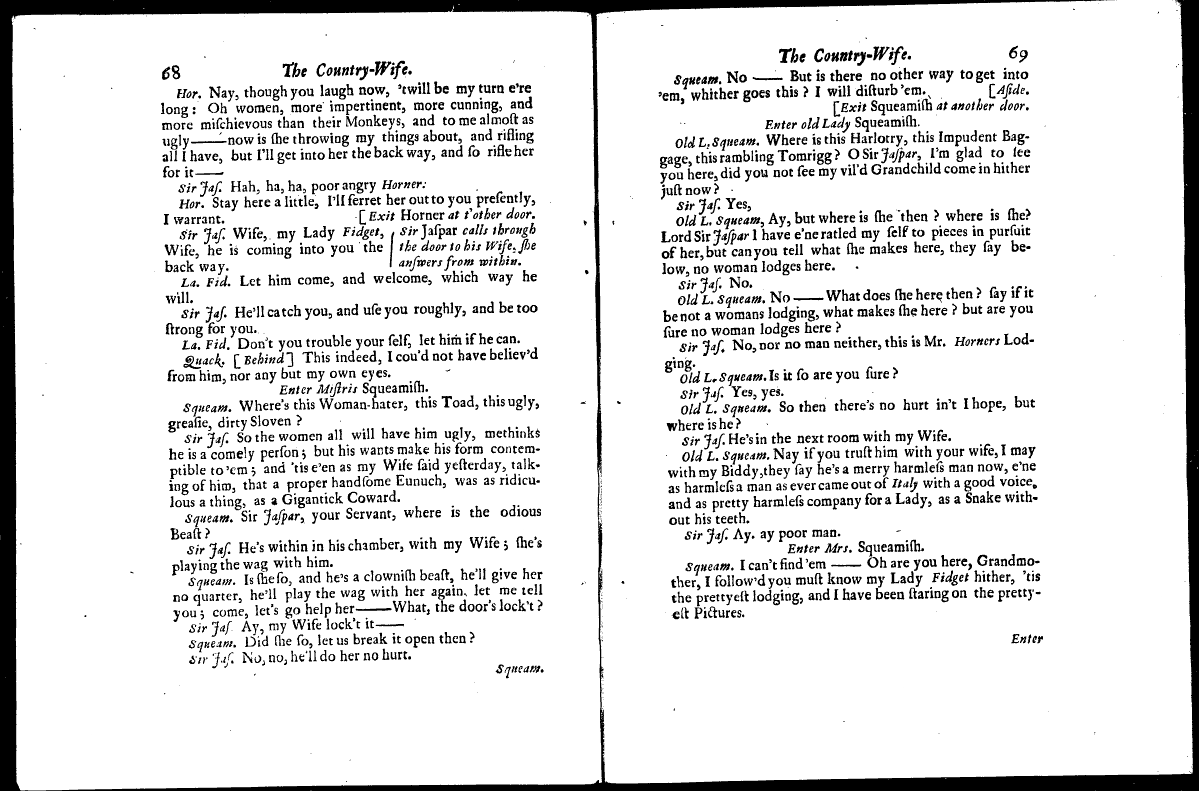
The complete book at ECCO
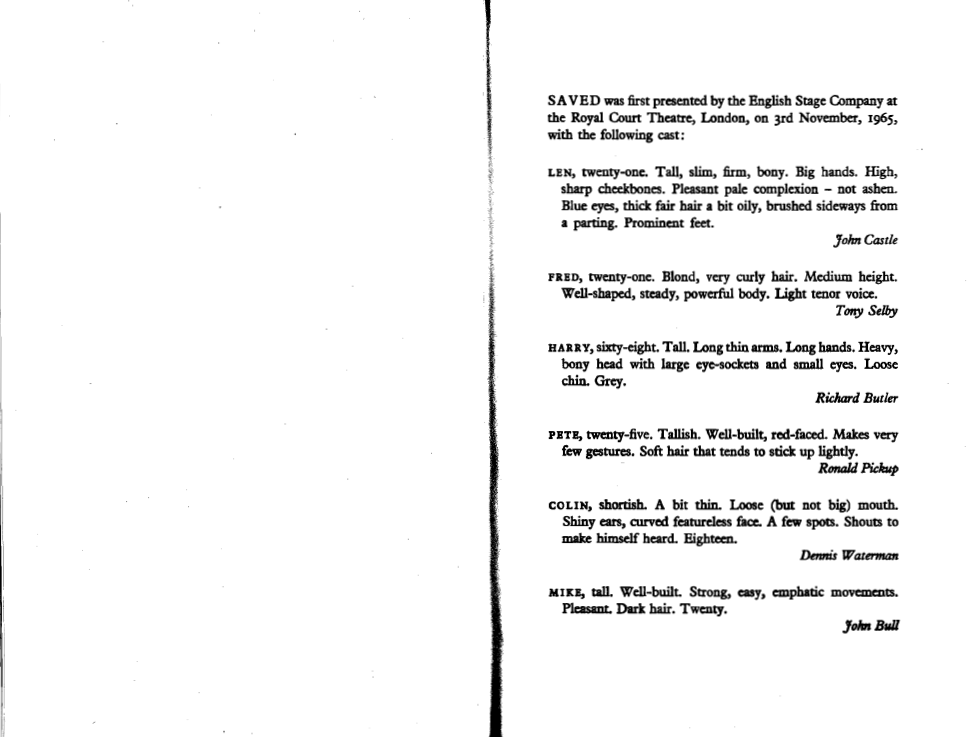
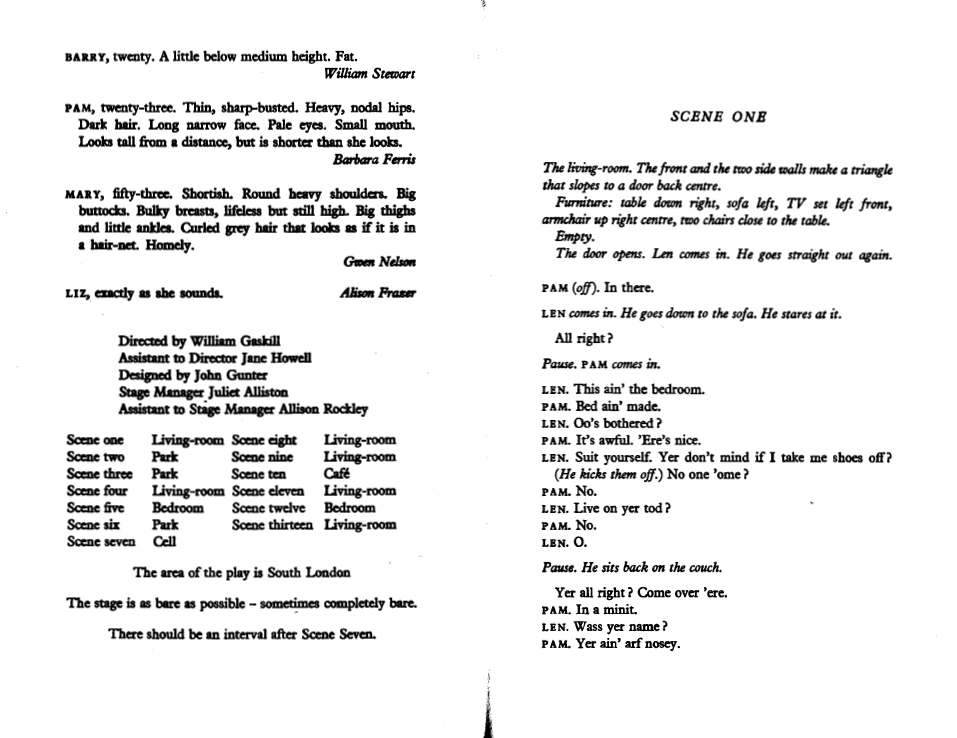
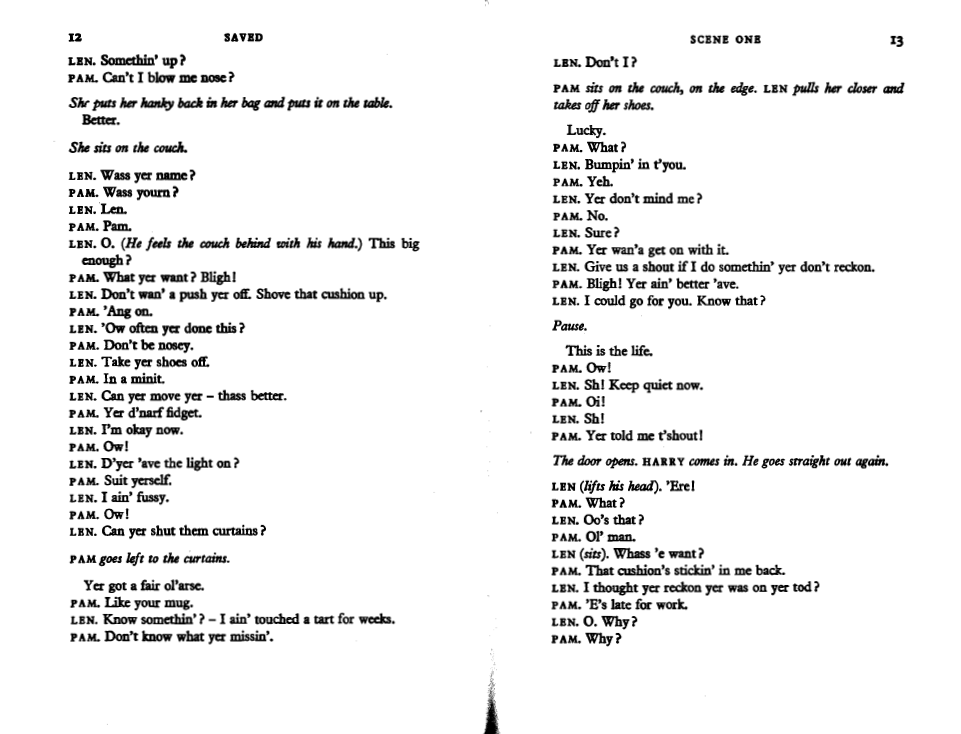

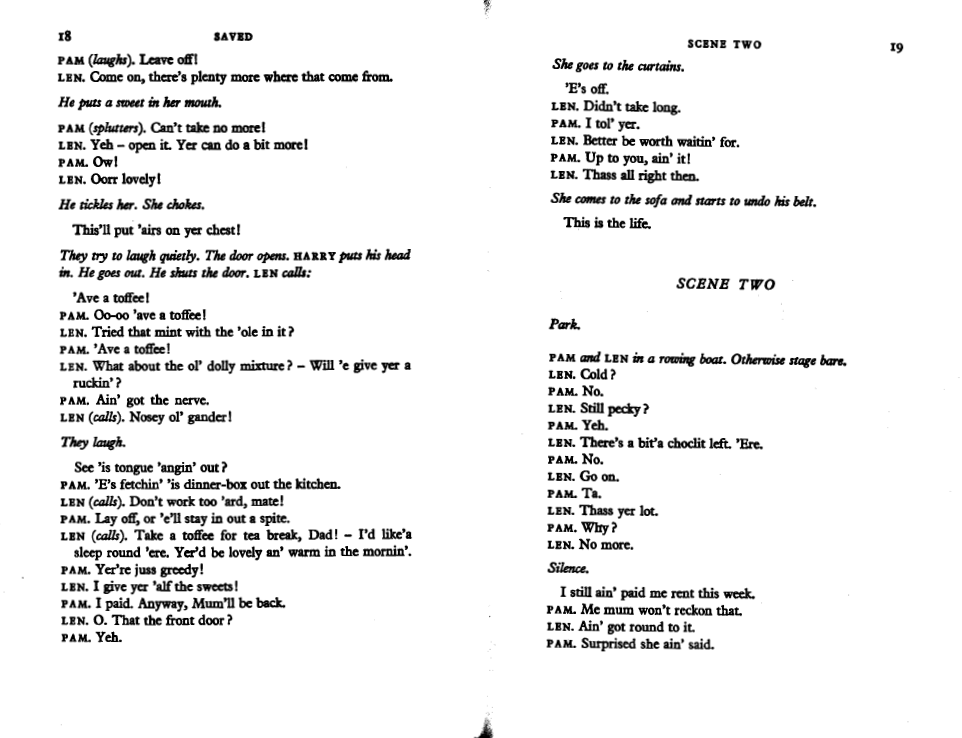
An analysis of literature can support any of these notions - they do not yield unexpected results
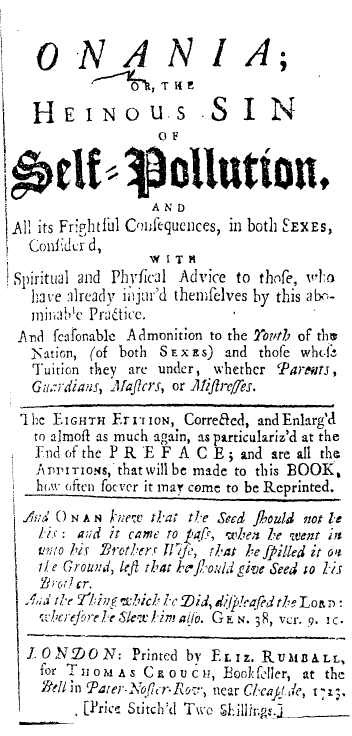 |
|
 |
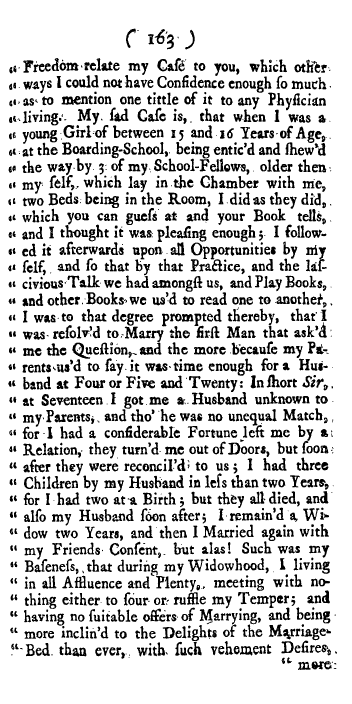 |
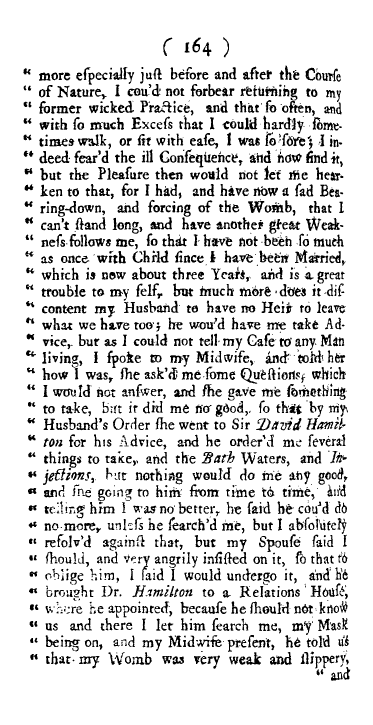 |
 |
 |
the complete book at ECCO
Thus daily at two in the afternoon, London has two, sometimes three plays running in different places, competing with each other, and those which play best obtain most spectators. The playhouses are so constructed that they play on a raised platform, so that everyone has a good view. There are different galleries and places, however, where the seating is better and more comfortable and therefore more expensive. For whoever cares to stand below only pays one English penny, but if he wishes to sit he enters by another door and pays another penny, while if he desires to sit in the most comfortable seats, which are cushioned, where he not only sees everything well, but can also be seen, then he pays yet another English penny at another door. And during the performance food and drink are carried round the audience, so that for what one cares to pay one may also have refreshment. The actors are most expensively and elaborately costumed; for it is the English usage for eminent lords or knights at their decease to bequeath and leave almost the best of their clothes to their serving men, which it is unseemly for the latter to wear, so that they offer them then for sale for a small sum to the actors.
Thomas Platter, Diary (1599). [source: Norton Anthology Webpage]
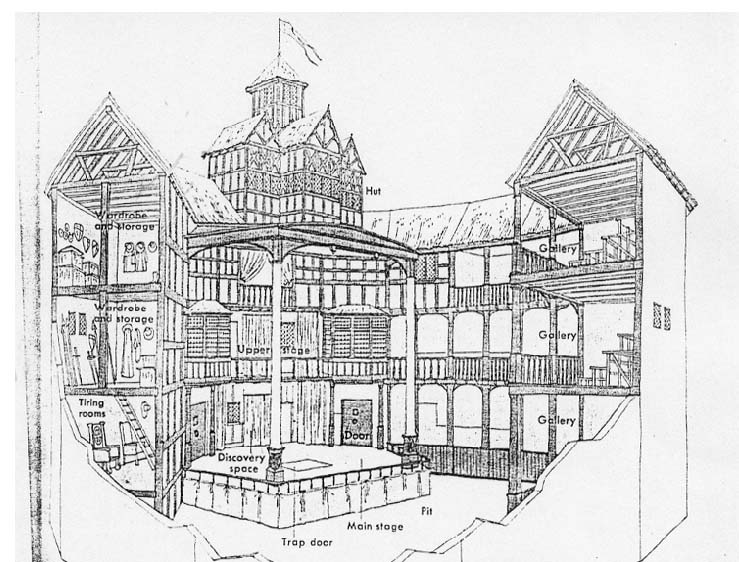
Globe cutaway [source: http://www.willshakespeare.com/pictures.htm]

Brueghel, Peeter, the younger, Boerenkermes, detail: booth stage

A panorama of London by Claes Van Visscher, 1616. Old St Paul's had lost its spire by this time. The two theatres on the foreground (Southwark) side of the Thames are the Bear Garden and The Globe. The large church in the foreground is St Mary Overie, now Southwark Cathedral. [source: en.wikipedia.org]

 |
 |
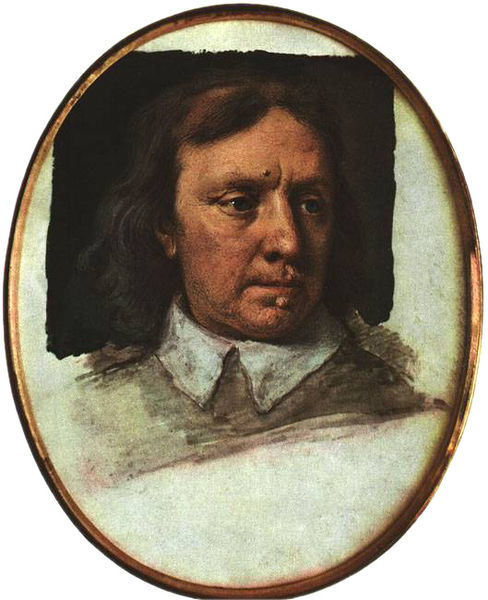 |
 |
| James I, 1603-1625 | Charles I, 1625-1649 | Oliver Cromwell, 1649-1658 | Charles II, 1660-1685 |
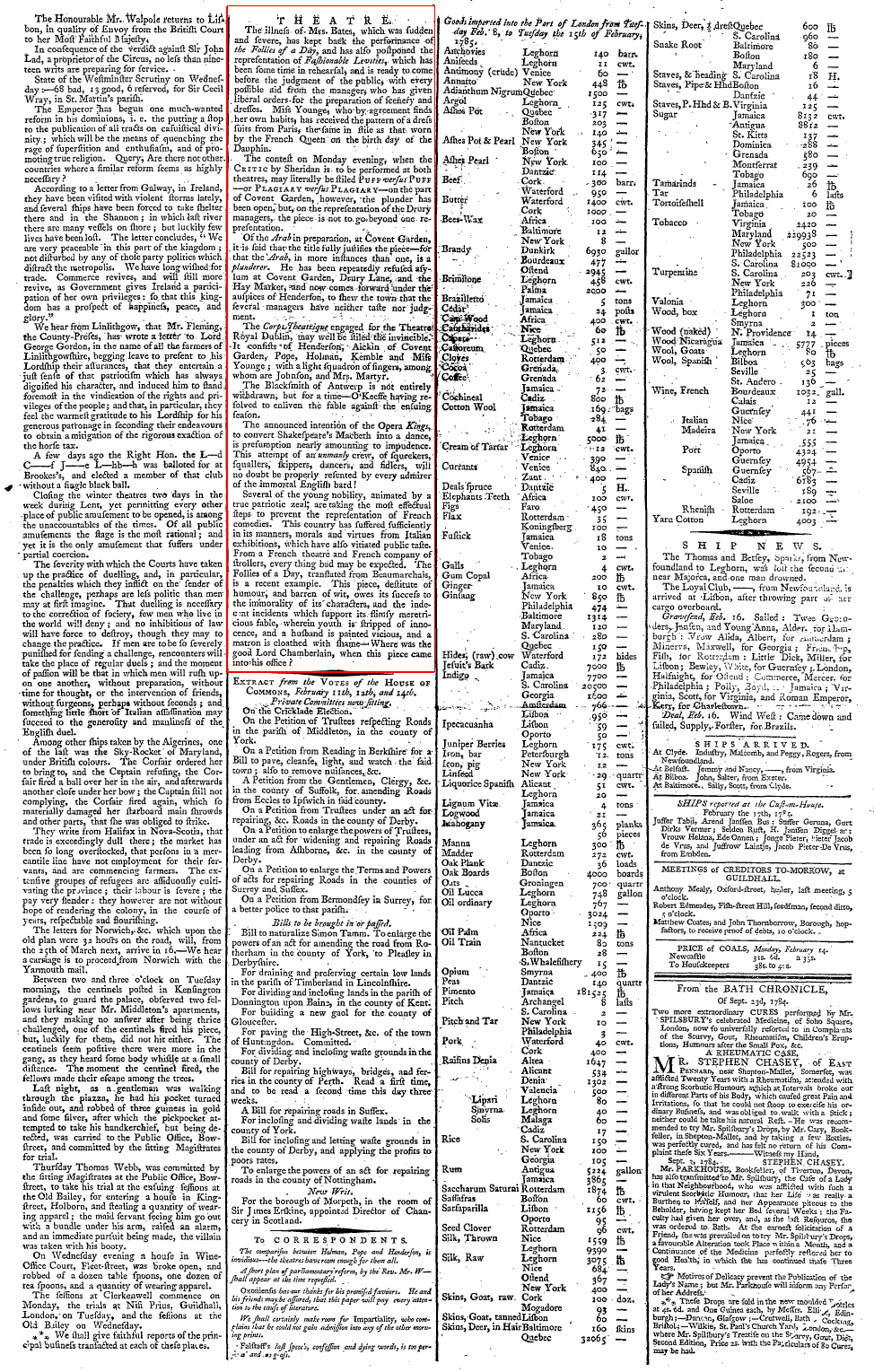
The distinction between “legitimate” and “illigigtimate” drama referred to the permissions granted to the two patent theatres (Covent Garden and Drury Lane) to present serious drama such as the plays of Shakespeare. The other 'illegitimate' theatres could only stage pieces with music and dancing. In the 19th century the distinction came to be used to indicate serious drama as opposed to farce or musical comedy.
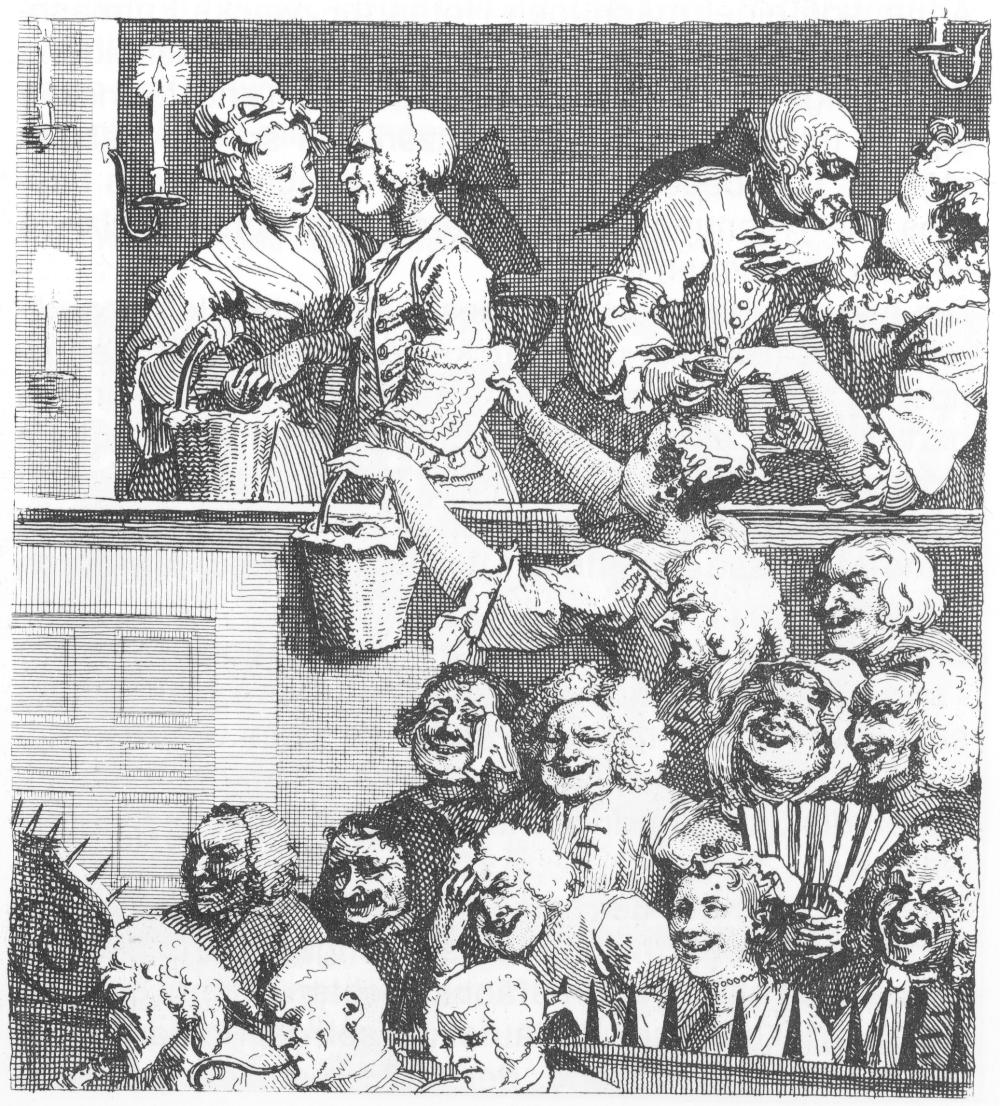
The Laughing Audience is divided into three sections which depict three classes of people. The fops in the top register are portrayed as both more refined and more distant from the dramatic experience than the working class audience in the pit, who seem to be enjoying the performance in an unselfconscious manner. The orange girls, the only 'industrious' characters portrayed in the print, are drawn with the serpentine “Line of Beauty.” Round, pleasant faces with long foreheads and delicate noses such as theirs will later be used by Lavater as examples of simplicity, innocence, and moral beauty. The print was used as a subscription ticket for Southwark Fair (1733) and A Rake's Progress (1735). It is signed by Hogarth himself. [source: http://www.ogerstung.de]
[...] a new species of dramatic composition has been introduced under the name of ‘sentimental comedy’, in which he virtues of private life are exhibited, rather than the vices exposed; and the distresses rather than the faults of mankind make our interest in the piece. These comedies have had of late great success, perhaps from their novelty, and also from their flattering every man in his favourite foible. In these plays almost all the characters are good, and exceedingly generous [...]. If they happen to have faults or foibles, the spectator is taught not only to pardon, but to applaud them, in consideration of the goodness of their hearts; so that folly, instead of being ridiculed, is commended, and the comedy aims at touching our passions without the power of being truly pathetic. [...] Humor at present seems to be departing from the stage, and it will soon happen that our comic players will have nothing left for it but a fine coat and a song. It depends upon the audience whether they will actually drive those poor merry creatures from the stage, or sit at a play as gloomy as at the Tabernacle.
Oliver Goldsmith, A Comparison between Laughing and Sentimental Comedy (1773). [source: link]

Comedy and Tragedy (1807). [source: PeoplePlay-uk]
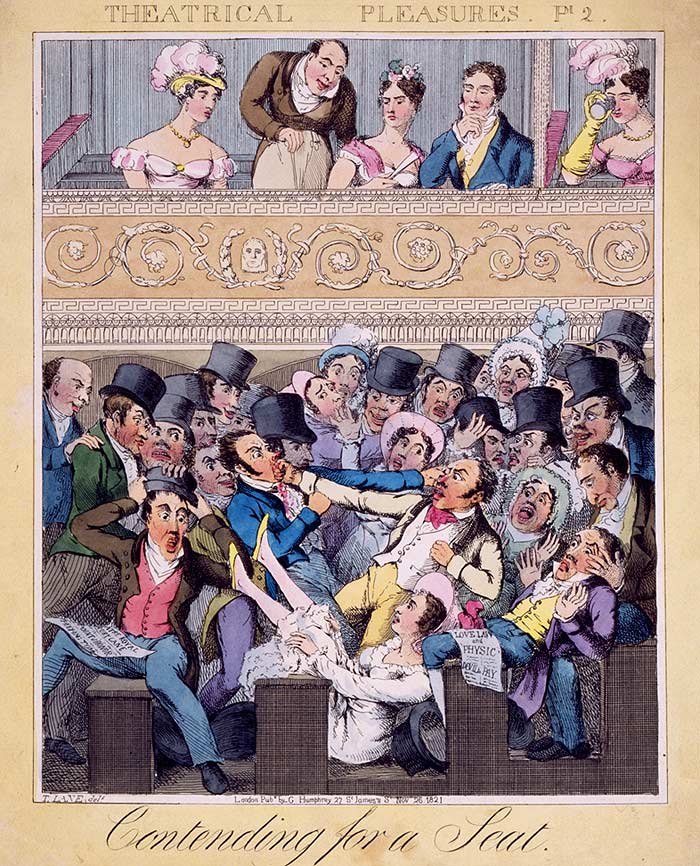
Audiences were not always well behaved as this cartoon of Drury Lane in 1821 illustrates. The lady who has been knocked off her seat has unwittingly revealed rather more of her person than she intended, and everyone is too busy watching the fight to take any notice of the play. Even the well dressed figures in the spacious box above look on with interest. While not a daily occurrence, outbreaks such as this were not uncommon. A critic of a performance of The Pirate’s Doom in 1827 mentioned that the play ‘would have been more effective, but for a real battle in the pit, to which the screams of the women impart a truth and reality, that quite spoilt the effect of the stage combats.’ [source: PeoplePlay-uk]
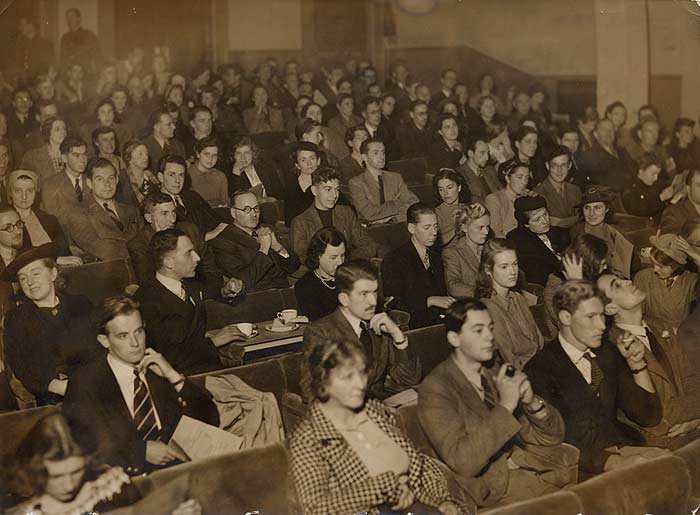
The Arts Theatre Club in London's West End opened in 1927 to provide 'the amenities of a London Club and a congenial place for those interested in the theatre on both sides of the curtain'. Because it was a club it was not subject to normal censorship regulations and could stage unusual productions even if they had been banned by the Lord Chamberlain. During World War 2 ballet became extremely popular and the Arts Theatre put on daytime performances of ballets. From 1940 the hour long Lunchtime Ballet was packed daily with civilians grabbing a sandwich before returning to work, and servicemen on leave. It proved so successful that an After Lunch Ballet performance was added, then Tea Ballet followed by an After Tea Ballet and by 1941 an early evening Sherry Ballet. [source: PeoplePlay-uk]
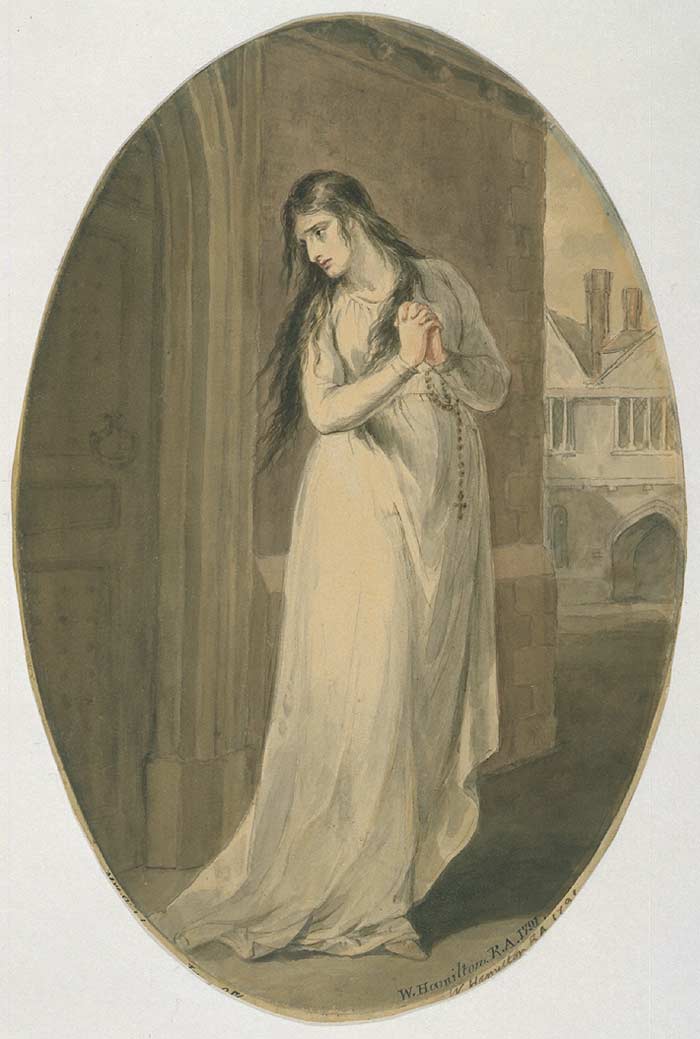
Sarah Siddons began performing as part of her parents' troupe of strolling players. Her success was enough to catch the attention of David Garrick, then nearing the end of his career. He brought her to London in 1775, but she failed to make an impression on the public. When she returned to London in 1782, with Drury Lane under the management of playwright Richard Sheridan, Siddons was already the rage in fashionable Bath. She played eighty times in seven different parts in her first proper London season, inducing faintings and hysterics amongst her audiences. Nicholas Rowe's The Tragedy of Jane Shore afforded Mrs Siddons one of her greatest opportunities for realistic acting. As Jane Shore, drifting half-starved about the streets of London, eye-witnesses report that the audience 'absolutely thought her the creature perishing through want', and 'could not avoid turning from the suffering object'. [source: PeoplePlay-uk]
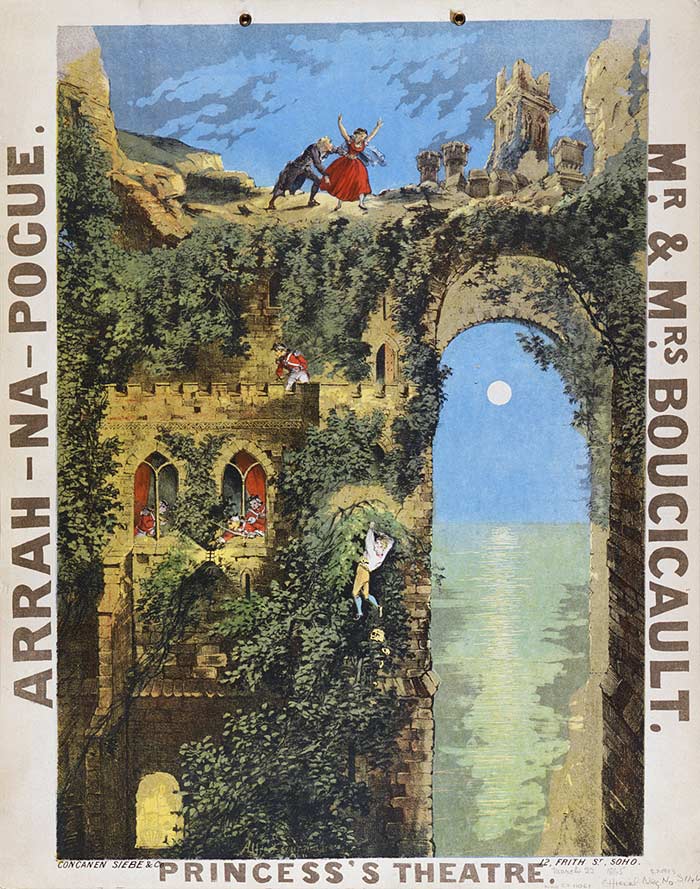
Arrah-Na-Pogue; or, The Wicklow Wedding first played at Dublin in the autumn of 1864. Dion Boucicault wrote himself the part of Shaun the Post, whose lively wit made him a London favourite at the Princess’s Theatre when the play transferred there in March 1865. His wife Agnes Robertson played Arrah Meelish, known as Arrah of the Kiss from her method of passing a letter with escape plans to her foster brother Beamish in prison. Arrah is engaged to Shaun, but Beamish - now escaped - robs Feeney, a government inspector, and gives the papers he steals to Arrah. To save her, Shaun confesses to the crime. While escaping from his prison in Dublin Castle, he fights Feeney and flings him to his death. It was this ‘sensation scene’, with the ivy-clad tower scenery sliding down to represent Shaun’s climb to the top, which was used for the posters. The run at the Princess’s coincided with a Fenian reign of terror. On 13th December 1865 a cask of gunpowder, set off at Clerkenwell prison to liberate Irish prisoners, caused nearly 20 deaths and injured more than 100 people. The Prince of Wales, attending the show that night, went backstage and asked ‘Boucicault, are you a Fenian?’ Boucicault replied, ‘No, sir, I am not a Fenian, but I am an Irishman’. [source: PeoplePlay-uk]

The Standard Theatre succeeded The Curtain, where many of Shakespeare’s plays were first performed, as Shoreditch’s main theatre. As a non-patent theatre it had to survive by putting on variety acts and concert performances, and by producing ‘illegitimate drama’ (dramatic plays with musical interludes or underscoring added to evade the restrictions of the licensing laws). In 1848 John Douglass became the sole lessee. He enlarged and improved the theatre, redecorating the interior and, according to the Illustrated Sporting and Dramatic News, ‘altogether changing and improving the character of its entertainments’. By the 1880s the same journal reported that the Standard stood ‘in the same relation to East-end melodrama as Drury Lane does to West-end pantomime’. Given that this was during the heyday of Augustus Harris’s spectacular pantomimes, this was high praise. Further improvements were made in 1897, by the new lessee Mrs Melville. The Telegraph praised the ‘new and commodious playhouse’ where ‘instead of comparatively narrow circles and galleries, and a large waste of space in the centre of the auditorium, we now have deep projecting balconies ranged one above the other’ and ‘a handsome and cheerful style of decoration’. [source: PeoplePlay-uk]

Benjamin Oliver took the name George Conquest and with his son George (born in 1837) ran the Grecian Saloon, built in the grounds of the Eagle Tavern, from 1851 to 1879. Bound to Succeed; or, A Leaf from the Captain’s Log Book was the first piece played in the rebuilt and refurbished theatre in 1877, when the Grecian was advertised as ‘one of the largest and most beautiful theatres in London, and capable of holding nearly 5,000 persons’. According to the programmes it was ‘an entirely New and Original Drama of London and Tasmanian Life’ with scenes set in Van Diemen’s Land, Tasmania, and Tasmania Dock on the River Thames. It was co-written by George Conquest Senior and starred him as Christopher Wobbles, ‘a neglected genius’, and his son George as ‘a nervous gentleman’. The poster dates from a later production, after the Conquests transferred to the Surrey Theatre in 1881, having sold the Grecian for £21,000 to an aspiring impresario who soon parted with it, at a loss, to the Salvation Army. [source: PeoplePlay-uk]

Herbert Beerbohm Tree and his wife Maud (born Helen Maud Holt) had been married ten years when they appeared opposite each other in Hamlet at the Haymarket in 1892. Although Tree’s Hamlet was compared unfavourably with Irving’s, the notices were still warm. Clement Scott, reviewing the production for the London Illustrated News thought him ‘one of the most classical of all the Hamlets shown to us by a very young man’ (a generous description given that Tree was 39 at the time!). He saved most of his accolades for Maud: Mrs Tree’s Ophelia will be among my most delightful memories. There was no staginess here, no trick, no artificiality... an Ophelia most graceful, most beautiful, most persuasive. Maud’s insistence on having fresh flowers on stage each night for Ophelia to rip up clearly gave her acting the edge she hoped it would. [source: PeoplePlay-uk]

Madge Kendal, pictured here with her husband, the actor William Kendal, did much to improve the standards in the Victorian theatre and to bring it a respectability that would appeal to the middle classes. The couple imposed a high moral code both on stage and behind the scenes. Kendal was the youngest of William Robertson’s 22 children and her family had been connected with the theatre for 200 years. Her brother Tom Robertson, was a dramatist whose work introduced the naturalistic cup-and-saucer type drama that rapidly became the fashion. The couple went into management together at the Court Theatre and the St James's Theatre. Although a sparkling comedian on the stage, and referred to in magazines as ‘dear Madge Kendal’, Mrs Kendal was by all accounts a cold and judgmental character. She disapproved of people and practices that did not conform to her strict code, and she had a poor relationship with her own five children. Her acting was outstanding however, and she was made a Dame in 1926. [source: PeoplePlay-uk]

The Sins of Society, produced at Drury Lane in 1907, contained more sensational scenes created by Bruce Smith and his fellow designers at the theatre, Henry Emden and R.McCleery. There was a dramatic scene at a weir in which the hero, wrongly suspected, dived into the waters to escape police pursuit. The Tatler thought this ‘a splendid example of stage realism... never before has real water poured over a weir so realistically’. This photograph is of Smith’s set for the troopship S.S.Beachy Head, which involved our hero in another spectacular moment as ‘he alone escapes from the sinking troopship which, with ordered discipline and soldiers singing the National Anthem as they await their death, affords a superb spectacle of patriotism’ (The Sketch). [source: PeoplePlay-uk]
Edward Gordon Craig’s stage design for a production of Shakespeare’s Much Ado About Nothing

This set was designed by Edward Gordon Craig for a production of Shakespeare’s Much Ado About Nothing starring his mother, Ellen Terry in 1903. Terry was Henry Irving’s leading lady for 24 years, and Craig began performing with Irving’s company at the Lyceum as a teenager but soon turned to directing and designing. Theatre design in Irving’s generation aimed to recreate the location of each scene in accurate detail. Craig revolutionised attitudes to design by creating sets that were modern, sparse and imaginative, but which made no attempt to imitate life (which Craig saw was impossible and therefore ridiculous). The spaces he created were evocative and flexible, and uncluttered in a way that threw the focus onto the actor, much as had been the case in Elizabethan times. This set for Much Ado About Nothing with its moveable columns was Craig’s last production in England, as British producers were reluctant to use such unconventional designs. [source: PeoplePlay-uk]
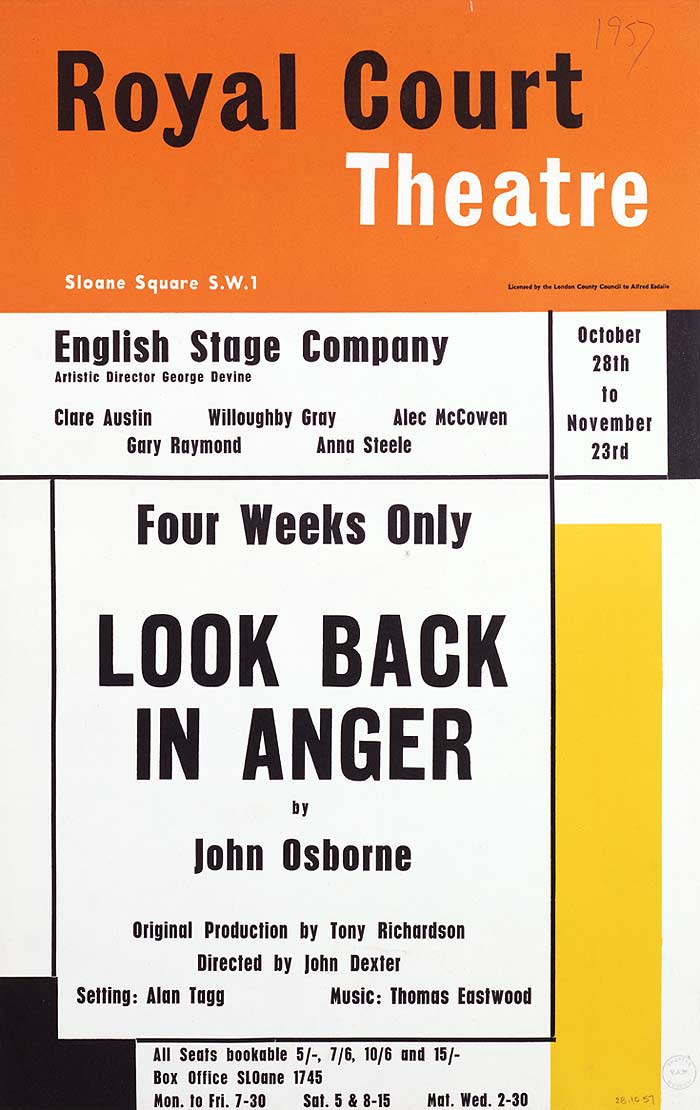
The rise of television in the 1950s, bringing personalities into people's front rooms, influenced the production of theatre posters featuring photographs of stars, such as that for The Mousetrap. Unlike West End theatres though, the Royal Court Theatre was not a theatre concerned with celebrity, but with the production of the best work of new playwrights. The English Stage Company opened at the Royal Court in 1956 as a subsidised company producing new British plays, international plays and some classical revivals. George Devine, its first artistic director, wanted to create a writers' theatre,’ ‘a place where the dramatist is acknowledged as the fundamental creative force in the theatre and where the play is more important than the actors, the director, the designer’. The English Stage Company developed a house style for its poster and programme and used this format for this poster for John Osborne's play Look Back in Anger, and for all their posters and programme covers in 1957 and 1958. [source: PeoplePlay-uk]
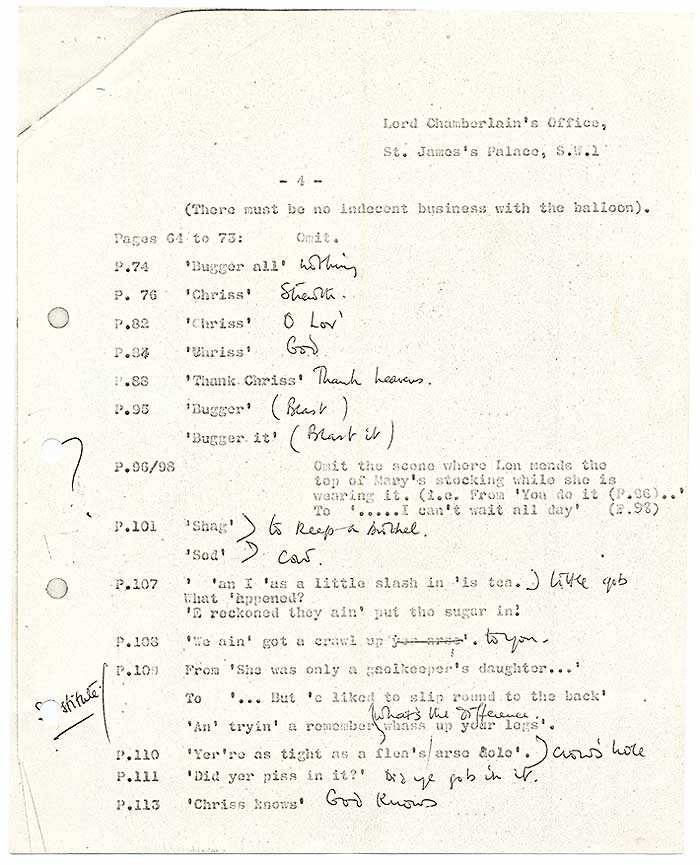
Saved by Edward Bond was commissioned by the Royal Court Theatre in 1964. It is set in the cramped, urban environment of South London, and shows the effects of an act of violence (the stoning of a baby) on a group of ordinary people. All plays at that time still had to be checked and sanctioned by the Lord Chamberlain. William Gaskill, the director at the Royal Court, knew from the outset that Bond’s play would not be passed, and recommended that Bond cut out the swear words and sexual references in the hope that the violent scenes, which were integral to the play, would be allowed. Bond refused to do this, or to cut two scenes which the Lord Chamberlain refused to permit. Eventually, the play was produced as a club performance for members of the English Stage Society in 1965. (Private clubs were not subject to censorship laws as technically they did not give public performances.) The outraged response to the play brought the arguments about censorship to a head, and in 1968, the law was changed and censorship ceased. The recommended second word is probably “Struth” for God’s truth (still in use in Australia). [source: PeoplePlay-uk]
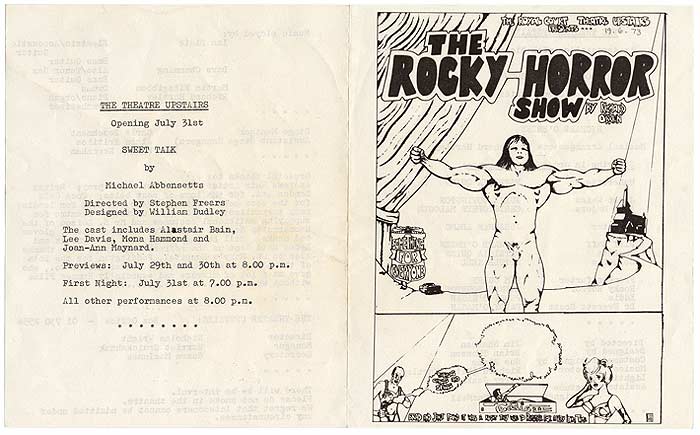
The Rocky Horror Show began as a six week workshop project in June, 1973 in the Royal Court's tiny 60-seat Theatre Upstairs, from which this programme comes. Richard O'Brien wrote the book, music and lyrics, as a homage to horror films, and the show is an outrageous assemblage of science fiction movies, Marvel comics, and rock'n'roll. Two middle American smalltown kids are confronted by the sexual complications of the decadent 1970s, represented in the person of the mad 'doctor' Frank N. Furter, a 'sweet transvestite' from the planet Transexual in the galaxy of Transylvania. Tim Curry played the role at the Royal Court and went on to huge success in the transfer and in the film The Rocky Horror Picture Show. The show rapidly outgrew the Royal Court and transferred first to a converted cinema and then to the 500-seat King's Road Theatre where it sold out nightly. With the 1975 film version and numerous provincial productions, the show has taken on cult status. People dress up in the style of the characters, and there are set audience responses. You can even find an 'audience participation script' online. [source: PeoplePlay-uk]

...search the web for debates of Edward Bond's Saved (1965) and the legitimiation of violence as a topic artists have to address.